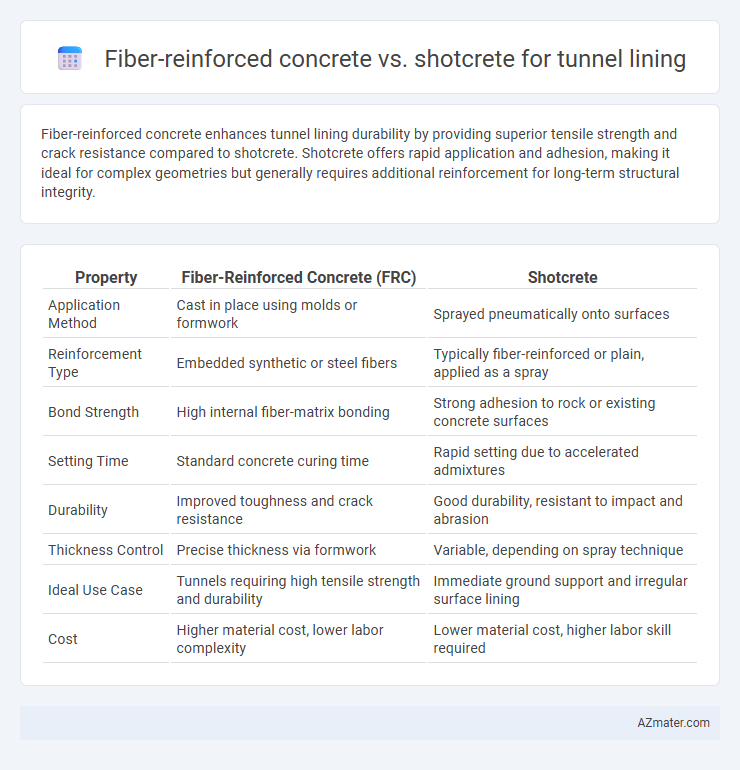Fiber-reinforced concrete enhances tunnel lining durability by providing superior tensile strength and crack resistance compared to shotcrete. Shotcrete offers rapid application and adhesion, making it ideal for complex geometries but generally requires additional reinforcement for long-term structural integrity.
Table of Comparison
| Property | Fiber-Reinforced Concrete (FRC) | Shotcrete |
|---|---|---|
| Application Method | Cast in place using molds or formwork | Sprayed pneumatically onto surfaces |
| Reinforcement Type | Embedded synthetic or steel fibers | Typically fiber-reinforced or plain, applied as a spray |
| Bond Strength | High internal fiber-matrix bonding | Strong adhesion to rock or existing concrete surfaces |
| Setting Time | Standard concrete curing time | Rapid setting due to accelerated admixtures |
| Durability | Improved toughness and crack resistance | Good durability, resistant to impact and abrasion |
| Thickness Control | Precise thickness via formwork | Variable, depending on spray technique |
| Ideal Use Case | Tunnels requiring high tensile strength and durability | Immediate ground support and irregular surface lining |
| Cost | Higher material cost, lower labor complexity | Lower material cost, higher labor skill required |
Introduction to Tunnel Lining Methods
Tunnel lining methods primarily include fiber-reinforced concrete (FRC) and shotcrete, both essential for structural integrity and durability. Fiber-reinforced concrete utilizes synthetic or steel fibers to enhance tensile strength and crack resistance, offering improved load-bearing capacity in tunnel linings. Shotcrete, applied pneumatically, provides a rapid, adaptable solution with excellent adhesion and reduced formwork needs, making it ideal for complex tunnel geometries.
Overview of Fiber-Reinforced Concrete
Fiber-reinforced concrete (FRC) enhances tunnel lining durability by incorporating synthetic or steel fibers that improve tensile strength, crack resistance, and impact absorption. It offers superior performance compared to traditional concrete and shotcrete due to its homogeneous fiber distribution, reducing shrinkage and enhancing load-bearing capacity. FRC is particularly effective in mitigating micro-cracking and improving long-term structural integrity in tunnel applications.
Understanding Shotcrete Technology
Shotcrete technology involves the pneumatically applied, high-velocity spraying of concrete onto tunnel surfaces, enabling rapid placement and excellent adhesion even on complex geometries. Fiber-reinforced shotcrete enhances the material's tensile strength, crack resistance, and durability, making it particularly suited for tunnel linings exposed to dynamic loads and ground movements. The integration of fibers within shotcrete improves structural integrity and reduces the need for additional reinforcement compared to traditional fiber-reinforced concrete cast in formwork.
Material Properties Comparison
Fiber-reinforced concrete (FRC) offers enhanced tensile strength, ductility, and crack resistance due to the inclusion of steel, glass, or synthetic fibers, making it highly effective in controlling crack propagation and adding toughness in tunnel linings. Shotcrete, typically composed of a dry or wet mortar mix sprayed at high velocity, provides rapid placement and excellent adhesion to irregular surfaces, but its mechanical properties depend heavily on mix design and application technique, often exhibiting lower tensile strength without fiber reinforcement. When comparing material properties, FRC generally surpasses standard shotcrete in flexural strength and durability, while fiber-reinforced shotcrete variants combine the benefits of both methods for optimal structural performance in tunnel lining applications.
Installation and Application Techniques
Fiber-reinforced concrete offers enhanced durability and crack resistance, applied using traditional casting methods with formwork tailored to tunnel contours, enabling uniform distribution of fibers for consistent structural strength. Shotcrete, applied via pneumatic spraying directly onto tunnel surfaces, allows for rapid installation and excellent adhesion to irregular geometries, minimizing the need for formwork and accelerating construction schedules. Both methods require careful mix design to optimize fiber content or spray parameters, ensuring effective bonding, workability, and longevity in tunnel lining applications.
Structural Performance in Tunnel Conditions
Fiber-reinforced concrete (FRC) enhances structural performance in tunnel linings by improving crack resistance, ductility, and impact absorption under dynamic loads. Shotcrete offers rapid application and strong adhesion to irregular tunnel surfaces, providing immediate support and load distribution. While FRC excels in long-term durability and tensile strength, shotcrete's adaptability and quick setting make it essential for initial tunnel stabilization in challenging underground conditions.
Durability and Longevity
Fiber-reinforced concrete enhances tunnel lining durability through improved crack resistance and reduced permeability, extending service life under aggressive environmental conditions. Shotcrete, while offering rapid application and strong initial adhesion, may exhibit higher susceptibility to shrinkage cracks and lower long-term durability without fiber integration. Incorporating fibers in shotcrete formulations maximizes toughness and longevity, making fiber-reinforced shotcrete a superior choice for durable tunnel linings.
Cost Considerations and Economic Impact
Fiber-reinforced concrete (FRC) offers cost savings in tunnel lining through reduced labor and formwork expenses, thanks to faster placement and improved crack control, while shotcrete minimizes material waste and accelerates application on irregular surfaces, lowering overall project timelines. The economic impact of FRC includes decreased maintenance costs due to enhanced durability, whereas shotcrete provides financial benefits by enabling more flexible construction methods and reducing the need for heavy equipment. Evaluating project-specific factors like tunnel geometry, labor rates, and long-term performance is essential to optimize cost efficiency between fiber-reinforced concrete and shotcrete solutions.
Environmental and Safety Aspects
Fiber-reinforced concrete (FRC) enhances tunnel lining durability by reducing cracking and improving impact resistance, minimizing maintenance frequency and associated environmental disruption. Shotcrete allows rapid application in tunnel construction, decreasing exposure to airborne dust and chemical additives, thereby improving worker safety and reducing ecological footprint. Both materials contribute to sustainable practices; however, FRC's reduced permeability and higher tensile strength offer better long-term protection against water ingress and structural failure, aligning with stringent environmental and safety regulations.
Choosing the Right Solution for Tunnel Projects
Fiber-reinforced concrete offers enhanced tensile strength and crack resistance, making it ideal for long-term structural integrity in tunnel linings. Shotcrete provides rapid application and excellent adhesion to irregular surfaces, which is beneficial in complex or urgent tunnel construction scenarios. Evaluating project-specific factors such as load requirements, environmental conditions, and construction timelines is essential for selecting the optimal material in tunnel lining applications.

Infographic: Fiber-reinforced concrete vs Shotcrete for Tunnel lining
 azmater.com
azmater.com